米什金货币金融学(商学院版)第9章课件
货币金融学课件米什金讲述

2-5
Structure of Financial Markets 金融市场的结构
• Exchanges and Over-the-Counter (OTC) Markets 交易所和场外交易(柜台交易)市场
Copyright © 2010 Pearson Addison-Wesley. All rights reserved.
2-14
Regulation of the Financial System 金融体系的监管
• To increase the information available to © 2010 Pearson Addison-Wesley. All rights reserved.
2-12
Table 3 Primary Assets and Liabilities of Financial Intermediaries 表2-3 金融中介机构主要的资产和负债
• Debt and Equity Markets 债务市场和股权市
场
– Debt instruments (maturity) 债务工具(期限) – Equities (dividends) 股权(股息或红利)
• Primary and Secondary Markets
一级市场和二级市场
– Investment Banks underwrite securities in primary markets 投资银行在一级市场中承销证券 – Brokers and dealers work in secondary markets 经纪人和交易商在二级市场中经营业务
Mishkin 米什金 货币银行学 课件

G ro w th R a te
100
G D P G ro w th R a te
$ 9 .5 trillio n $ 9 trillio n $ 9 trillio n
113 111 111
1 0 0 5 .6 %
In f la tio n R a te
3
Chapter 1
Why Study Money, Banking, and Financial Markets?
Why Study Money,Banking and Financial Markets
Why Study Financial Markets?
1. Channel funds from savers to investors, thereby promoting economic efficiency 2. Affect personal wealth and behavior of business firms
3. Financial Innovation
Why Study Money and Monetary Policy?
1. Influence on business cycles, inflation, and interest rates
5பைடு நூலகம்
Bond Market
6
Stock Market
7
Foreign Exchange Market
Why Study Banking and Financial Institutions?
1. Financial Intermediation
Helps get funds from savers to investors
货币金融学课件第九章

商业银行是现代金融体系中的主体,是最 重要的金融中介机构。与我们的生活息息相关, 在市场经济中发挥着重要且不可替代的作用。
现代商业银行是从早期的货币经营业演变 而来的。要理解现代商业银行的产生,有必要 了解早期货币经营业及其业务特点。
4
第9章 商业银行业务与管理
9.1.1 商业银行的产生与发展
10
第9章 商业银行业务与管理
9.1.1 商业银行的产生与发展 商业银行的基本特征
经营的主要目标是盈利
商业银行
:
:
基本业务是负债业务和资产业务
是存款货币的主要提供者
11
第9章 商业银行业务与管理
9.1.1 商业银行的产生与发展
有了货币,自然就有了多余货币的储蓄问题。古人存钱不外两种方式: 存入储蓄机构;藏在自己家里。
第9章 商业银行业务与管理
第9章 商业银行业务与管理
本章学习要求
在这一章中,我们将学习有关商业银行的基本理论, 如商业银行的概念与起源、职能作用、组织结构以及未 来的发展趋势;学习商业银行的基本业务,如资产负债 业务、中间及表外业务;还要学习有关商业银行的一些 基本管理方法,学完本章后,你应当知道:
21
第9章 商业银行业务与管理
9.2.2 商业银行的资本管理
二、商业银行资本金的构成
根据巴塞尔协议的规定,商业银行资本金必须包括以 下两个部分并且应该达到风险资产的8%,其中核心资本 应达到其50%。附属资本不能超过核心资本的100%。
17
第9章 商业银行业务与管理
9.1.3 商业银行的制度
三、商业银行 的组织结构:
各种委员会
股东大会 董事会 总经理
监事会 总稽核
米什金 货币金融学 课件
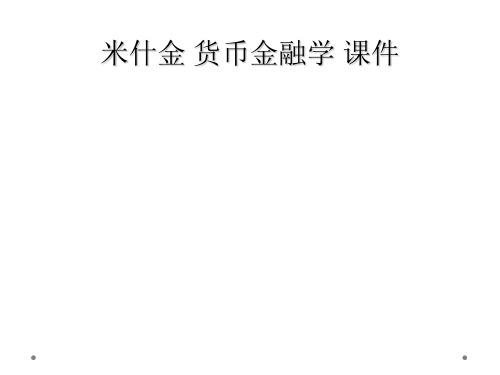
• 所谓股票市场,是各种公司收益的权证 (股票)进行交易的场所,它在经济活 动中起着非常重要的作用。
• 股票市场作为最活跃的金融市场,其状 况往往是经济形势变化的晴雨表。股票 价格的上下波动是变幻莫测的,这种变 动对经济活动会产生很大影响 。
四.金融市场的重要性及其与货 币银行的联系
的统称,各种不同重要性
• 3.货币和其他经济现象 • (1)货币与经济周期。 • (2)货币与货币政策。 • (3)货币与预算赤字。
总结
• 总之,货币、银行与金融市场是非常重要的, 它们不仅与人们的日常生活密切相关,影响人 们的财富规模、投资和消费行为,而且会影响 企业的市场价值、生产和销售行为,同时也会 影响一个国家的财富总量、政局稳定和政策效 应。通过学习货币银行学的有关知识,我们可 以更透彻地理解各种经济现象,从而更好地安 排一生的投资、消费,最大限度地增进个人的 经济福利。
七.与货币银行学有关的几个事 实
• 1.大部分金融公式——无论它们有多么 复杂——都以复利为基础
• ⒉长期贷款的利率通常高于短期贷款的 利率
• ⒊ 为了理解利率如何影响经济决策,你 必须考虑预期通货膨胀
• ⒋购买股票是使你的财富增加的最好方 式——同时也是最坏方式
七.与货币银行学有关的几个事 实
五.银行和金融机构及其重要性
• 4.银行体系与金融创新 • (1)许多金融法规已经不能适应金融创新的发展,
管制当局对金融体系监管的难度加大了。 • (2)金融创新伴生的过度投机行为,不仅严
重损害了广大投资人的公共利益,而且妨碍了 金融体系的健康发展。 • (3)金融创新使国际金融市场的一体化程度 大大提高了。 • (4)金融创新对各国在金融体系监管的国际 协调提出了更高的要求。
货币金融学米什金
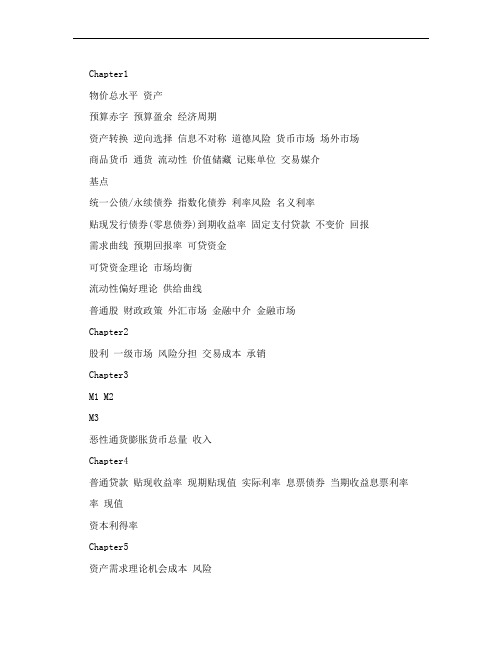
Chapter1物价总水平资产预算赤字预算盈余经济周期资产转换逆向选择信息不对称道德风险货币市场场外市场商品货币通货流动性价值储藏记账单位交易媒介基点统一公债/永续债券指数化债券利率风险名义利率贴现发行债券(零息债券)到期收益率固定支付贷款不变价回报需求曲线预期回报率可贷资金可贷资金理论市场均衡流动性偏好理论供给曲线普通股财政政策外汇市场金融中介金融市场Chapter2股利一级市场风险分担交易成本承销Chapter3M1 M2M3恶性通货膨胀货币总量收入Chapter4普通贷款贴现收益率现期贴现值实际利率息票债券当期收益息票利率率现值资本利得率Chapter5资产需求理论机会成本风险超额需求超额供给费雪效应Chapter6无违约风险债券预期理论翻转的收益率曲线流动性溢价理论期限优先理论适应性预期现金流量股利有效市场假定随机游走戈登增长模型市场基本面代理理论银行业恐慌现金流量抵押品债务萎缩金融危机搭便车鼓励相容啄食顺序假定资产管理资产负债表资本充足性管理补偿余额信用配给信用风险存款外流贴现贷款贴现率久期分析股本乘数超额准备金缺口分析利率风险风险溢价利率的风险结构分割市场理论利率的期限结构收益率曲线Chapter7最优预测未被利用的盈利机会理性预期剩余索取权有效资本市场理论推广的股利估值模型Chapter8委托-代理理论限制性条款担保债务高额核实成本资不抵债净值无担保债务风险投资公司Chapter9负债管理流动性管理贷款承诺贷款出售表外业务法定准备金率法定准备金准备金资产回报率股权回报率二级准备金 T账户库存现金Chapter10自动银行机自动提款机存款利率上限脱媒银行破产银行监管巴塞尔协议商誉年金封闭式基金共同保险免赔额固定受益型计划固定缴费型计划足额基金对冲基金美式期权套利买入期权货币互换欧式期权执行价格衍生金融工具金融期货合约金融期货期权远期合约避险远期利率合约利率互换公开市场操作目标独立性贴现率金融衍生工具期货合约证券化Chapter11杠杆比率表外业务监管套利监管宽容Chapter12初次公开发行(IPO)付佣基金非付佣基金开放式基金再保险适时发行不足额基金承销商Chapter13长头寸综合避险保证金盯市单个避险名义本金未平仓合约期权期权费卖出期权短头寸股票期权互换Chapter14工具独立性Chapter15超额准备金浮款高能货币基础货币多倍存款创造公开市场操作公开市场购买货币乘数防御性市场操作贴现窗口能动性公开市场操作联邦基金率工具指标中介指标国际政策协调自然失业率非加速型通货膨胀失业率升值资本流动性贬值有效汇率指数配额现汇率汇率汇率超调外汇市场国际收支平衡表资本账户固定汇率制度国际货币基金组织官方储备交易余额特别提款权非冲销性外汇干预国际收支危机经常账户公开市场出售法定准备金率法定准备金准备金简单存款乘数Chapter16非借入基础货币Chapter17最后贷款人再买回交易(反回购协议)一级交易商回购协议Chapter18操作指标菲利普斯曲线真实票据原则泰勒规则Chapter19远期汇率现汇交易关税远期交易利息平价条件一价定律货币中性购买力平价理论Chapter20外汇干预国际储备储备货币冲销性外汇干预世界银行布雷顿森林体系法定贬值金本位制度有管理的浮动制度法定升值货币局美元化铸币税交易方程式货币理论实际货币余额总需求总需求函数浮躁情绪自主性消费支出净出口存货投资消费函数可支配收入总需求曲线长期货币中性积极干预主义者总需求总需求曲线总供给总供给曲线浮躁情绪自我纠错机制供给冲击货币流通速度后遗效应凯恩斯主义者长期总供给曲线现代货币数量论耐用消费品支出贸易余额Chapter21名义锚时间一致性问题Chapter22流动性偏好理论货币数量论货币流通速度Chapter23支出乘数固定投资消费支出计划投资支出 LS曲线 LM曲线边际消费倾向政府支出Chapter24总产出的自然水平完全挤出Chapter25货币主义者完全挤出效应消费支出交易方程式政府支出非加速通货膨胀型失业率非积极干预主义者部分挤出效应计划投资支出真是经济周期理论总产出的自然率水平净出口Chapter26消费信用途径消费简化形式实证分析适应性政策单一货币增长规则成本推进型通货膨胀需求拉动型通货膨胀计量经济模型政策无效命题结构模型实证分析货币政策传导机制 Chapter27 政府预算约束债务货币化李嘉图平衡式政府印钞 Chapter28。
第九章金融危机与次贷风波(货币金融学米什金版第九版)

1.1资产市场对资产负债表的影响
股市下跌 ——企业净值减少,削弱贷款人的放款意愿 ——企业净值减少,增加了借款公司参与高风险投资的动力 物价水平的意外下跌 ——增加公司负债的实际价值(加重了债务负担),减少企业 净值 本币意外贬值 ——国内企业的外币标价的债务负担加重,减少企业净值 资产减值 ——导致金融机构资产负债表中资产方的价值减值
CDO ABS
图.次贷产品链条
CDS
3.1抵押市场上出现的金融创新
3.1抵押市场上出现的金融创新
SPV : special purpose vehicle CDO :担保债务权证 CDS :信用违约互换
3.2 次贷价格泡沫的形成
• 次贷市场的发展和膨胀以及美国宏观经济 政策的转变等多个因素交织在一起,不断 催生了次贷泡沫的胀大和破裂。 • (一)美联储极具扩张性的货币政策 • (二)房价攀升与次贷业务的繁荣 • (三)金融监管的放松 • (四)商业银行盈利模式的改变
3.6 银行的资产负债表恶化
美国银行2007年第四季度利润下降95% ,主 要因为SIV投资。为了防止SIV进一步损失,2007年 12月,汇丰银行率先将450亿美元SIV纳入其资产 负债表,渣打银行、花旗银行等紧随其后,开始 了表外资产向表内回归的过程。然而问题在于, 这些原本不透明的资产回归资产负债表,使银行 资产负债表内风险更不确定,反而打击了投资者 的信心和信任。
第九章 金融危机与次贷风波
本章预习
•金融危机(financial crisis),是以资产价格急剧下 降与企业破产为特征的金融市场的大动荡 •2007年8月开始,次贷危机引爆了美国自大萧条以来 最为严重的金融危机 •美联储前主席格林斯潘认为 次贷危机是一场 “百年不遇的金融海啸”
米什金货币金融学(英文)PPT (9)

Banking and the Management of Financial Institutions
© 2005 PearsoБайду номын сангаас Education Canada Inc.
The Bank Balance Sheet
© 2005 Pearson Education Canada Inc.
© 2005 Pearson Education Canada Inc.
9-11
Managing Interest Rate Risk
First Bank Assets Rate-sensitive assets $20 m $50 m Variable-rate loans Short-term securities Overnight funds Fixed-rate assets $80 m Reserves Long-term bonds Long-term securities
© 2005 Pearson Education Canada Inc. 9-3
Principles of Bank Management
1. Liquidity Management 2. Asset Management
Managing Credit Risk
Managing Interest-rate Risk
© 2005 Pearson Education Canada Inc.
9-9
Capital Adequacy Management
1. Bank capital is a cushion that helps prevent bank failure 2. Higher is bank capital, lower is return on equity ROA = Net Profits/Assets ROE = Net Profits/Equity Capital EM = Assets/Equity Capital ROE = ROA EM Capital , EM , ROE 3. Tradeoff between safety (high capital) and ROE 4. Banks also hold capital to meet capital requirements 5. Managing Capital: A. Sell or retire stock B. Change dividends to change retained earnings © 2005 Pearson Education Canada Inc. C. Change asset growth
《金融学第九章》课件

金融市场的证券化趋势
金融市场的证券化趋势是指通过证券化技术,将传统的实物资产转化为证券资产,从而实现资产的流动性和可交易性。证券化趋势的发展推动了金融市场的创新和发展,为投资者提供了更多的投资选择和风险管理工具。
促进经济增长:金融市场创新与发展能够促进经济增长。一方面,金融市场创新能够提高资金配置效率和资本形成速度,推动产业升级和经济结构调整;另一方面,金融市场发展能够扩大内需和消费,促进经济增长。
风险转移
金融市场的风险可以通过转移的方式进行降低。投资者可以通过购买保险或利用衍生品等工具将风险转移给其他市场参与者。
风险分散
金融市场的风险可以通过分散投资的方式进行降低。投资者可以通过投资不同类型的资产或选择不同的投资组合来降低风险。
风险补偿
金融市场的风险与回报之间存在一定的关系。投资者可以通过承担更高的风险来获得更高的回报,但同时也需要承担更大的损失。
市场基础设施监管
对金融创新产品进行监管,包括衍生品、资产证券化等,确保其合规性和风险可控性。
金融创新与监管
通过制定和执行相关法律法规,对违法违规行为进行惩罚,维护市场秩序和公平竞争。
法律手段
监管机构采取行政手段对金融机构和市场进行监督和管理,包括现场检查、非现场监管等。
行政手段
行业自律组织对会员进行监督和管理,制定行业自律规则和标准,促进行业规范发展。
案例二:美国长期资本管理公司破产案
巴林银行由于内部风险管理不善,导致巨额亏损并最终破产。此案例说明了操作风险和市场风险的重要性。
THANKS。
05
金融市场的风险与防范
法律风险
与法律或监管规定不符的风险。
操作风险
由于内部操作失误或系统故障导致的风险。
对外经济贸易大学金融专业考研(米什金)《货币金融学》辅导讲义9
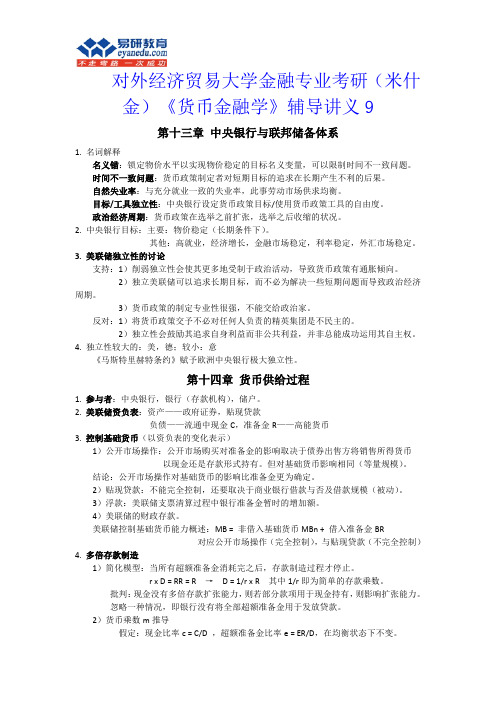
1. 货币政策有很长的时滞。 2. 没人知道真是的经济模型是什么样的。 3. 经济随时都在发生变化,因此泰勒规则的系数不可能一成不变。 4. 次贷危机要求货币政策作出调整,不应使用一成不变的自动制定机制。 3)例题:假定均衡的实际 iff 与适当的通胀目标均为 2%,缺口权重均是 0.5,
通胀率为 3%,产出缺口是 1%,计算 iff 指标 (6%)。 5. 央行应对资产价格泡沫的反应:次贷危机的教训 1)资产价格泡沫:1. 信贷驱动型:(相对容易确认)机理:信贷繁荣推高资产价格。
2. 中央银行目标:主要:物价稳定(长期条件下)。 其他:高就业,经济增长,金融市场稳定,利率稳定,外汇市场稳定。
3. 美联储独立性的讨论 支持:1)削弱独立性会使其更多地受制于政治活动,导致货币政策有通胀倾向。 2)独立美联储可以追求长期目标,而不必为解决一些短期问题而导致政治经济
周期。 3)货币政策的制定专业性很强,不能交给政治家。
米什金《货币金融学》第九章重点-2024鲜版

Chapter
2024/3/28
19
利率市场化改革的背景和意义
2024/3/28
计划经济向市场经济转型
01
随着改革开放的深入,我国由计划经济向市场经济转型,利率
市场化改革是这一过程中的重要环节。
ቤተ መጻሕፍቲ ባይዱ
金融市场发展的需要
02
金融市场的发展要求利率能够真实反映资金供求关系,形成市
场化的利率体系。
促进经济增长的需要
该理论认为,不同期限的债券市 场是相互分割的,各自有独立的 均衡点,因此收益率曲线的形状 是由不同市场的供求关系决定的。
预期理论
该理论认为,长期利率是未来短 期利率的预期平均值,收益率曲 线的形状反映了市场对未来短期 利率的预期。
流动性偏好理论
该理论认为,投资者对不同期限 的债券有不同的流动性偏好,因 此要求对不同期限的债券给予不 同的收益率补偿。
02
储蓄和投资是利率的决定因素:储蓄代表资本供给, 投资代表资本需求。
03
当储蓄大于投资时,利率下降;当储蓄小于投资时, 利率上升。
4
凯恩斯利率理论
2024/3/28
01 凯恩斯认为,利率不是由储蓄和投资决定,而是 由货币的供求决定。
02 货币是一种特殊的资产,人们持有货币是因为它 具有流动性。
03 利率是人们放弃流动性所得到的报酬,因此货币 供求平衡时的利率就是均衡利率。
2024/3/28
22
THANKS
感谢观看
2024/3/28
23
04
利率在货币政策中的作用
Chapter
2024/3/28
15
利率作为货币政策中介目标的优点
• 可测性:作为货币政策中介目标的变量应能够得到迅速且准确的观察和测量。 利率作为货币政策的中介目标,其可测性非常强,因为各国中央银行或货币当 局都能迅速获得关于利率的准确数据。
米什金《货币金融学》第9章
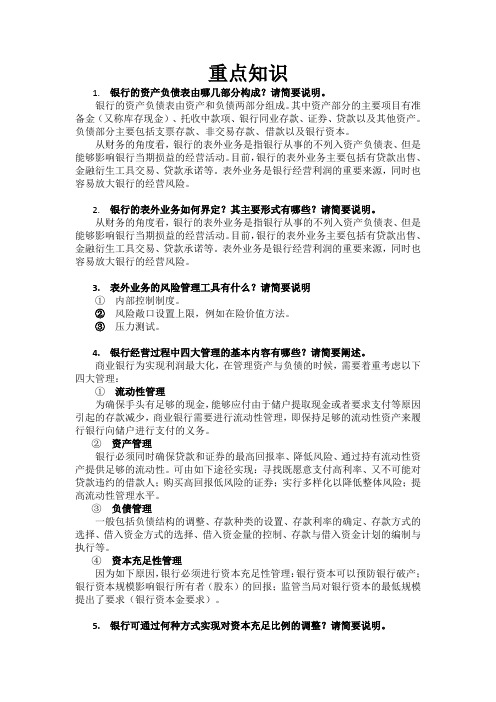
重点知识1.银行的资产负债表由哪几部分构成?请简要说明。
银行的资产负债表由资产和负债两部分组成。
其中资产部分的主要项目有准备金(又称库存现金)、托收中款项、银行同业存款、证券、贷款以及其他资产。
负债部分主要包括支票存款、非交易存款、借款以及银行资本。
从财务的角度看,银行的表外业务是指银行从事的不列入资产负债表、但是能够影响银行当期损益的经营活动。
目前,银行的表外业务主要包括有贷款出售、金融衍生工具交易、贷款承诺等。
表外业务是银行经营利润的重要来源,同时也容易放大银行的经营风险。
2.银行的表外业务如何界定?其主要形式有哪些?请简要说明。
从财务的角度看,银行的表外业务是指银行从事的不列入资产负债表、但是能够影响银行当期损益的经营活动。
目前,银行的表外业务主要包括有贷款出售、金融衍生工具交易、贷款承诺等。
表外业务是银行经营利润的重要来源,同时也容易放大银行的经营风险。
3.表外业务的风险管理工具有什么?请简要说明①内部控制制度。
②风险敞口设置上限,例如在险价值方法。
③压力测试。
4.银行经营过程中四大管理的基本内容有哪些?请简要阐述。
商业银行为实现利润最大化,在管理资产与负债的时候,需要着重考虑以下四大管理:①流动性管理为确保手头有足够的现金,能够应付由于储户提取现金或者要求支付等原因引起的存款减少,商业银行需要进行流动性管理,即保持足够的流动性资产来履行银行向储户进行支付的义务。
②资产管理银行必须同时确保贷款和证券的最高回报率、降低风险、通过持有流动性资产提供足够的流动性。
可由如下途径实现:寻找既愿意支付高利率、又不可能对贷款违约的借款人;购买高回报低风险的证券;实行多样化以降低整体风险;提高流动性管理水平。
③负债管理一般包括负债结构的调整、存款种类的设置、存款利率的确定、存款方式的选择、借入资金方式的选择、借入资金量的控制、存款与借入资金计划的编制与执行等。
④资本充足性管理因为如下原因,银行必须进行资本充足性管理:银行资本可以预防银行破产;银行资本规模影响银行所有者(股东)的回报;监管当局对银行资本的最低规模提出了要求(银行资本金要求)。
米什金货币金融学课件PPT课件

金融机构应遵守相关监管要求,包括资本充足率、流动性比率等, 以确保其稳健运营。
米什金货币金融学对经济发展的影响
经济增长
投资与储蓄
通过货币政策和金融市场的有效运作, 促进经济增长和就业。
影响人们的投资和储蓄行为,进而影 响经济发展。
金融稳定
维护金融市场的稳定,降低金融危机 发生的可能性。
THANKS
货币政策与货币供给
总结词
解释货币政策的目标、工具及如何影响货币供给。
详细描述
货币政策通常以稳定物价、促进经济增长和维持金融稳定为目标,通过调整利率 、存款准备金率等工具来影响货币供给,从而调控经济。
货币需求与货币流通速度
总结词
分析影响货币需求的因素以及货币流 通速度的变化规律。
详细描述
货币需求受到收入水平、利率、通货 膨胀预期等因素的影响,而货币流通 速度则与经济周期、金融市场发展等 因素相关,两者共同影响经济运行。
金融体系构成
金融机构、金融市场和金融监管 机构等在金融体系中的作用和相 互关系。
金融市场的功能与结构
金融市场的功能
提供资金供求匹配、风险分散和价格 发现等机制,促进资源优化配置。
金融市场的结构
场内交易与场外交易、现货市场与衍 生品市场、一级市场与二级市场等不 同类型市场的特点。
金融创新与金融监管
通货膨胀与价格水平
总结词
阐述通货膨胀的定义、成因及对价格水平的影响。
详细描述
通货膨胀是指物价普遍上涨的现象,成因包括货币供应过多、需求拉动、成本推动等,通货膨胀对价格水平的影 响表现为价格水平的上涨。
03
金融市场与金融机构
金融市场的构成与功能
金融市场的构成
2024年货币金融学课件第九章
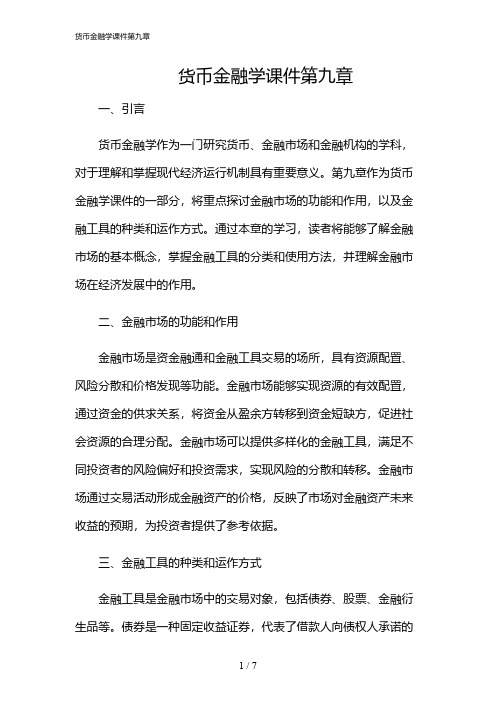
货币金融学课件第九章一、引言货币金融学作为一门研究货币、金融市场和金融机构的学科,对于理解和掌握现代经济运行机制具有重要意义。
第九章作为货币金融学课件的一部分,将重点探讨金融市场的功能和作用,以及金融工具的种类和运作方式。
通过本章的学习,读者将能够了解金融市场的基本概念,掌握金融工具的分类和使用方法,并理解金融市场在经济发展中的作用。
二、金融市场的功能和作用金融市场是资金融通和金融工具交易的场所,具有资源配置、风险分散和价格发现等功能。
金融市场能够实现资源的有效配置,通过资金的供求关系,将资金从盈余方转移到资金短缺方,促进社会资源的合理分配。
金融市场可以提供多样化的金融工具,满足不同投资者的风险偏好和投资需求,实现风险的分散和转移。
金融市场通过交易活动形成金融资产的价格,反映了市场对金融资产未来收益的预期,为投资者提供了参考依据。
三、金融工具的种类和运作方式金融工具是金融市场中的交易对象,包括债券、股票、金融衍生品等。
债券是一种固定收益证券,代表了借款人向债权人承诺的债务,具有固定的利率和到期日。
股票是公司的所有权证明,代表了股东对公司的所有权和分红权。
金融衍生品是基于其他金融工具的合约,包括期货、期权和互换等,用于对冲风险或进行投机。
金融工具的运作方式主要涉及发行、交易和兑付等环节。
发行是金融工具的创造过程,通过发行人向市场募集资金。
交易是金融工具在市场上的买卖活动,通过交易市场实现资金的流动和风险的转移。
兑付是金融工具到期时的本金和利息支付,是金融工具的最终回报。
四、金融市场在经济发展中的作用金融市场在经济发展中发挥着重要作用。
金融市场为企业和政府提供了融资渠道,促进了投资和消费的增长,推动了经济的发展。
金融市场提供了多样化的金融工具,满足了不同投资者的需求,促进了金融资源的有效配置。
金融市场通过价格发现机制,反映了市场对金融资产的评价和预期,为经济决策提供了重要参考。
五、结论货币金融学课件第九章主要介绍了金融市场的功能和作用,金融工具的种类和运作方式,以及金融市场在经济发展中的作用。
米什金货币银行学金融结构的经济学分析PPT学习教案

•
逆向选择(adverse selection)是交易之前发生的信息不对称 问题。 具有潜 在的不 良贷款 风险正 是那些 积极寻 求贷款 的人。
•
道德风险(moral hazard)是交易发生后出现的信息不 对称问 题。贷 款者发 放贷款 后会面 临这样 的风险 ,借款 者可能 会从事 那些从 贷款者 观点出 发不能 从事的 活动, 因为这 些活动 会提高 贷款违 约的可 能性。
•
信 息 的 私 人 生产和 销售 解决金融市场上逆向选择间题的办法,就是向资金供 应者提 供为投 资寻求 资金的 个人或 者公司 的详细 情况, 以消除 信息不 对称。 诸如标 准普尔 公司、 穆迪公 司和价 值线等 。但是 由于存 在搭 便 车 问 题 ( freபைடு நூலகம் rider problem) ,私人生产和销售信息的体 系并不 能完全 解决证 券市场 的逆向 选择问 题。
第6页/共22页
一、世界各国金融结构的基本事实
5.
在各种经济部门中,金融体系是受到 最为严 格监管 的部门 之一。
6.
只有那些规模庞大、组织完善的公司 才能易 于利用 证券市 场为其 经营活 动提供 融资。
7.
对于家庭和企业而言,抵押品是债务 合约的 一个普 遍特征 。
8.
典型的债务合约是极其复杂的法律文 件,它 对借款 者的行 为施加 了严格 的限制 。
•
旨 在 增 加 信 息供给 的政府 监管 政府对证券市场进行监管,鼓励公司披露真实信息, 使投资 者得以 识别公 司的优 劣。
•
安然破产案
•
视频:新闻背景:标准普尔公司
•
视频:标普短片公平的世界
第11页/共22页
四、次品车问题:逆向选择如何影响金融机构
- 1、下载文档前请自行甄别文档内容的完整性,平台不提供额外的编辑、内容补充、找答案等附加服务。
- 2、"仅部分预览"的文档,不可在线预览部分如存在完整性等问题,可反馈申请退款(可完整预览的文档不适用该条件!)。
- 3、如文档侵犯您的权益,请联系客服反馈,我们会尽快为您处理(人工客服工作时间:9:00-18:30)。
Copyright © 2010 Pearson Addison-Wesley. All rights reserved.
10-8
浦发银行2011年资产负债表
资产 现金及存放中央银行款 项 存放同业和其它金融机 构款项 拆出资金 买入返售金融资产 发放贷款及垫款 可供出售金融资产 持有至到期投资 负债 同业和其它金融机构存 放款项 拆入资金 吸收存款 负债合计
Copyright © 2010 Pearson Addison-Wesley. All rights rpital • The difference between total assets and liabilities.(8%) • Raised by selling new stock or from retained earnings. • Is a cushion against a drop in the value of its assets.
Copyright © 2010 Pearson Addison-Wesley. All rights reserved.
10-7
• • • • •
4.Securities An important income-earning asset.(23%) Made up entirely of debt instruments. 5. Loan Banks make their profits primarily by issuing loans. (66%) • Typically less liquid and have a higher probability of default than other assets. • 5. Other assets • The physical capital owned by the banks.
Copyright © 2010 Pearson Addison-Wesley. All rights reserved.
10-5
9.1.2 Assets
• 1. Reserves • Reserves = Vault cash + Deposits in an account at the central bank ( required reserves + excess reserves) • No interest payment. • Banks hold reserves for two reasons: • 1) Reserve requirement • 2) Reserves are the most liquid and can be used to meet its obligations when funds are withdrawn. • 中国的历次调整
10-13
9.3.1 Liquidity Management
Reserve requirement = 10%, Excess reserves = $10 million Assets Liabilities Reserves $20 million Deposits $100 million Loans $80 million Bank Capital $ 10 million Securities $10 million Deposit outflow of $10 million Assets Liabilities Reserves $10 million Deposits $ 90 million Loans $80 million Bank Capital $ 10 million Securities $10 million With 10% reserve requirement, bank still has excess reserves of $1 million: no changes needed in balance sheet
Copyright © 2010 Pearson Addison-Wesley. All rights reserved.
366,957,099,000 267,876,482,000 111,415,298,000 281,509,782,000 1,302,323,950,000 147,929,131,000 158,535,453,000
Copyright © 2010 Pearson Addison-Wesley. All rights reserved.
10-10
T-account Analysis: Deposit of $100 cash into First National Bank Assets Liabilities Vault Cash + $100 (=Reserves) Checkable Deposits + $100
Copyright © 2010 Pearson Addison-Wesley. All rights reserved.
/focus/zhbj2 10-6
• 2. Cash items in process of collection • Suppose a check written on an account at another bank is deposited in your bank and the funds for this check have not yet been received from the other bank. • 3. Deposits at other banks • Many small banks hold deposits in larger banks in exchange for a variety of services. • All of the above three are referred to as cash items. Importance shrinking over time.
10-11
Basic Banking: Making a Profit
First National Bank Assets Required reserves Excess reserves Liabilities +$100 Checkable deposits +$90 +$100 First National Bank Assets Required reserves Loans Liabilities +$100 Checkable deposits +$90 +$100
Copyright © 2010 Pearson Addison-Wesley. All rights reserved.
10-12
9.3 General Principles of Bank Management 1. Liquidity Management
2. Asset Management
Checkable Checkable Reserves Deposits Reserves Deposits + $100 + $100 – $100 – $100 Conclusion: When bank receives deposits, reserves by equal amount; when bank loses deposits, reserves by amount Copyrightequal © 2010 Pearson Addison-Wesley. All rights reserved.
Copyright © 2010 Pearson Addison-Wesley. All rights reserved.
10-3
• 2. Nontransaction Deposit • Primary source of bank funds. • Owners cannot write checks, but the interest rates are usually higher. • Two types: • --Savings accounts • --Time deposit: have a fixed maturity length. • 3. Borrowings • More and more important.
Deposit of $100 check into First National Bank Assets Liabilities Cash items in process of collection + $100 First National Bank Assets Liabilities Checkable Deposits + $100 Second National Bank Assets Liabilities
14% 10% 4% 10% 49% 6% 6%
440,908,269,000 66,970,025,000 1,851,055,121,000 2,535,150,909,000 149,542,780,000
16% 2% 69% 94% 6%
10-9
所有者权益合计
9.2 Basic Banking
Copyright © 2010 Pearson Addison-Wesley. All rights reserved.
10-14
Liquidity Management
